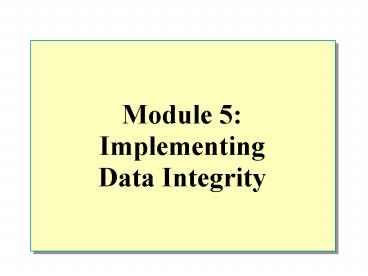Module 5: Implementing Data Integrity - PowerPoint PPT Presentation
1 / 23
Title:
Module 5: Implementing Data Integrity
Description:
Do Not Automatically Create Indexes ... CustomerID (PK) 3. Disabling Constraints. Disabling Constraint Checking on Existing Data ... – PowerPoint PPT presentation
Number of Views:244
Avg rating:3.0/5.0
Title: Module 5: Implementing Data Integrity
1
Module 5 Implementing Data Integrity
2
Overview
- Types of Data Integrity
- Enforcing Data Integrity
- Defining Constraints
- Types of Constraints
- Disabling Constraints
- Using Defaults and Rules
- Deciding Which Enforcement Method to Use
3
Types of Data Integrity
4
Enforcing Data Integrity
- Declarative Data Integrity
- Criteria defined in object definitions
- SQL Server enforces automatically
- Implement by using constraints, defaults, and
rules - Procedural Data Integrity
- Criteria defined in script
- Script enforces
- Implement by using triggers and stored procedures
5
Defining Constraints
- Determining Which Type of Constraint to Use
- Creating Constraints
- Considerations for Using Constraints
6
Determining Which Type of Constraint to Use
Type of integrity
Constraint type
Domain
DEFAULT
CHECK
REFERENTIAL
Entity
PRIMARY KEY
UNIQUE
Referential
FOREIGN KEY
CHECK
7
Creating Constraints
- Use CREATE TABLE or ALTER TABLE
- Can Add Constraints to a Table with Existing Data
- Can Place Constraints on Single or Multiple
Columns - Single column, called column-level constraint
- Multiple columns, called table-level constraint
8
Considerations for Using Constraints
- Can Be Changed Without Recreating a Table
- Require Error-Checking in Applications and
Transactions - Verify Existing Data
9
Types of Constraints
- DEFAULT Constraints
- CHECK Constraints
- PRIMARY KEY Constraints
- UNIQUE Constraints
- FOREIGN KEY Constraints
- Cascading Referential Integrity
10
DEFAULT Constraints
- Apply Only to INSERT Statements
- Only One DEFAULT Constraint Per Column
- Cannot Be Used with IDENTITY Propertyor
rowversion Data Type - Allow Some System-supplied Values
USE NorthwindALTER TABLE dbo.CustomersADDCONSTR
AINT DF_contactname DEFAULT 'UNKNOWN' FOR
ContactName
11
CHECK Constraints
- Are Used with INSERT and UPDATE Statements
- Can Reference Other Columns in the Same Table
- Cannot
- Be used with the rowversion data type
- Contain subqueries
USE NorthwindALTER TABLE dbo.EmployeesADD
CONSTRAINT CK_birthdateCHECK (BirthDate gt
'01-01-1900' AND BirthDate lt getdate())
12
PRIMARY KEY Constraints
- Only One PRIMARY KEY Constraint Per Table
- Values Must Be Unique
- Null Values Are Not Allowed
- Creates a Unique Index on Specified Columns
USE Northwind ALTER TABLE dbo.Customers ADD
CONSTRAINT PK_Customers PRIMARY KEY
NONCLUSTERED (CustomerID)
13
UNIQUE Constraints
- Allow One Null Value
- Allow Multiple UNIQUE Constraints on a Table
- Defined with One or More Columns
- Enforced with a Unique Index
USE Northwind ALTER TABLE dbo.Suppliers ADD
CONSTRAINT U_CompanyName UNIQUE NONCLUSTERED
(CompanyName)
14
FOREIGN KEY Constraints
- Must Reference a PRIMARY KEY or UNIQUE Constraint
- Provide Single or Multicolumn Referential
Integrity - Do Not Automatically Create Indexes
- Users Must Have SELECT or REFERENCES Permissions
on Referenced Tables - Use Only REFERENCES Clause Within Same Table
USE Northwind ALTER TABLE dbo.Orders ADD
CONSTRAINT FK_Orders_Customers FOREIGN KEY
(CustomerID) REFERENCES dbo.Customers(CustomerI
D)
15
Cascading Referential Integrity
CASCADE
NO ACTION
16
Disabling Constraints
- Disabling Constraint Checking on Existing Data
- Disabling Constraint Checking When Loading New
Data
17
Disabling Constraint Checking on Existing Data
- Applies to CHECK and FOREIGN KEY Constraints
- Use WITH NOCHECK Option When Adding a New
Constraint - Use if Existing Data Will Not Change
- Can Change Existing Data Before Adding Constraints
USE Northwind ALTER TABLE dbo.Employees WITH
NOCHECK ADD CONSTRAINT FK_Employees_Employees
FOREIGN KEY (ReportsTo) REFERENCES
dbo.Employees(EmployeeID)
18
Disabling Constraint Checking When Loading New
Data
- Applies to CHECK and FOREIGN KEY Constraints
- Use When
- Data conforms to constraints
- You load new data that does not conform to
constraints
USE Northwind ALTER TABLE dbo.Employees NOCHECK
CONSTRAINT FK_Employees_Employees
19
Using Defaults and Rules
- As Independent Objects They
- Are defined once
- Can be bound to one or more columns or
user-defined data types
CREATE DEFAULT phone_no_default AS
'(000)000-0000' GOEXEC sp_bindefault
phone_no_default, 'Customers.Phone'
CREATE RULE regioncode_rule AS _at_regioncode IN
('IA', 'IL', 'KS', 'MO')GOEXEC sp_bindrule
regioncode_rule, 'Customers.Region'
20
Deciding Which Enforcement Method to Use
21
Recommended Practices
22
Lab A Implementing Data Integrity
23
Review
- Types of Data Integrity
- Enforcing Data Integrity
- Defining Constraints
- Types of Constraints
- Disabling Constraints
- Using Defaults and Rules
- Deciding Which Enforcement Method to Use































